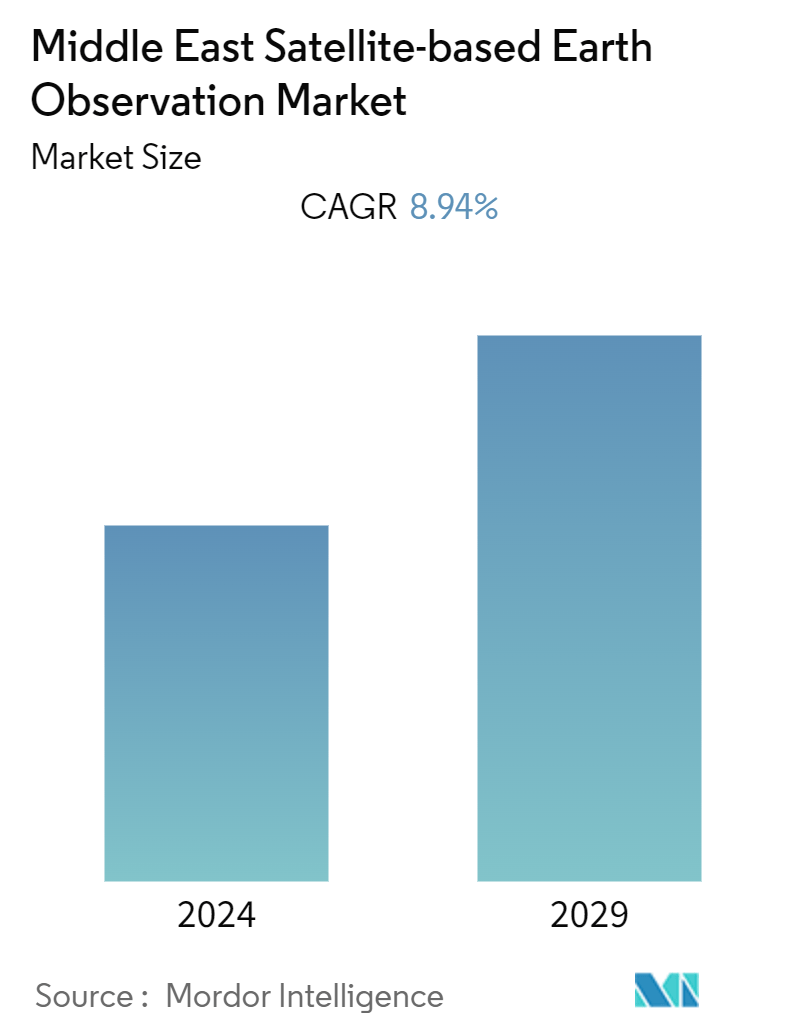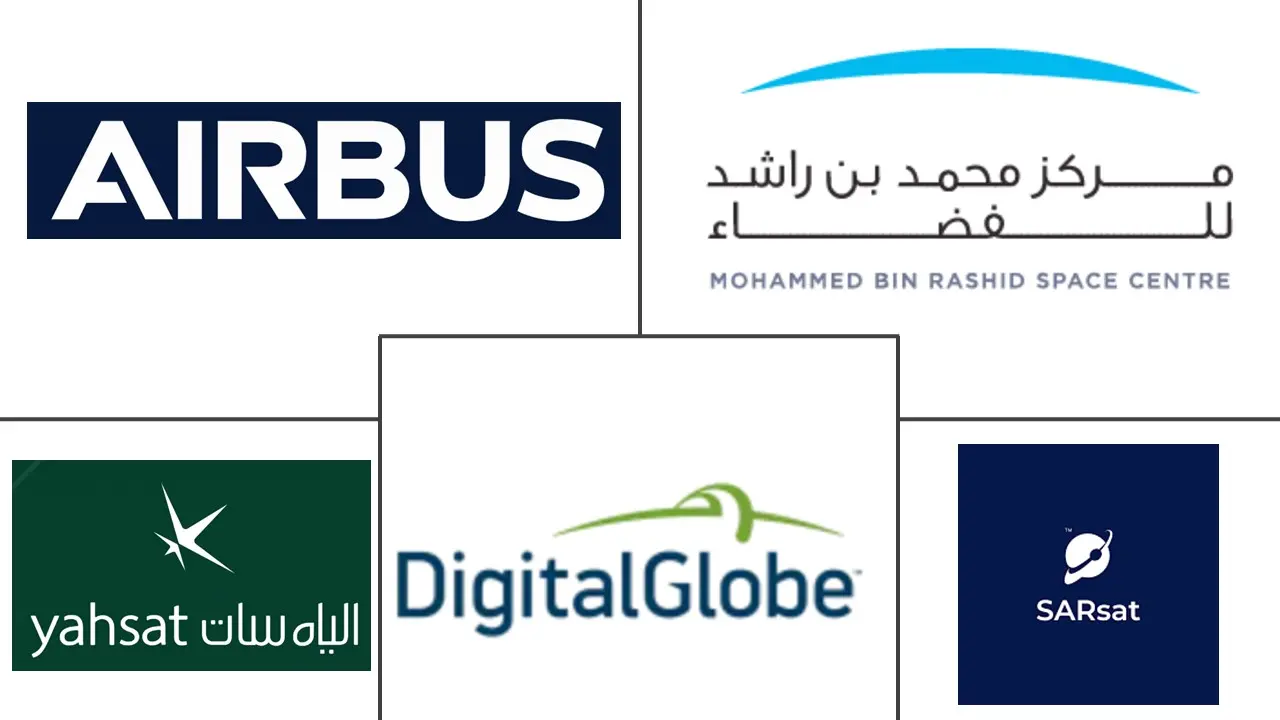Market Size of Middle East Satellite-based Earth Observation Industry

| Study Period | 2019 - 2029 |
| Base Year For Estimation | 2023 |
| Forecast Data Period | 2024 - 2029 |
| Historical Data Period | 2019 - 2022 |
| CAGR (2024 - 2029) | 8.94 % |
| Market Concentration | Medium |
Major Players
*Disclaimer: Major Players sorted in no particular order |
Middle East Satellite-based Earth Observation Market Analysis
The Middle East Satellite-based Earth Observation Market is expected to register a CAGR of 8.94% during the forecast period.
Remote sensing technology with earth observation is used in many industries to detect and monitor natural phenomena and human activities from a distance using various types of sensors such as optical, radar, and radio frequency. Remote sensing technologies are deemed essential to national capacities, with applications ranging from environmental mapping to urban development to public safety.
- The Middle East region has been investing in satellite-based earth observation services for various reasons, such as environmental monitoring and management, natural resource management, urban planning and development, disaster management, agriculture, and forestry management. These are some of the driving factors behind the growth of satellite-based earth observation services in the Middle East region.
- The growing use of satellites for environmental monitoring is one of the main factors driving the global expansion of the satellite-based earth observation industry. Satellite-based earth observation can be used for various purposes, including monitoring and tracking GHG emissions, deforestation, changes in polar ice, wildfires, and coral bleaching. Recent advancements in sensing and imaging technologies have resulted in the development of superior observation satellites for environmental monitoring. These satellites make it possible to measure numerous indicators and deliver photos with a higher resolution.
- As the region depends on oil exports, disaster management is essential due to the trade; partnerships are forming to minimize the damage and effectively contribute to the market.
- For instance, in June 2023, The Qatari Ministry of Environment & Climate Change received a Synthetic Aperture Radar (SAR*1) satellite-based oil spill detection service, which ITOCHU Corporation and SKY Perfect JSAT Corporation announced. This service, which employs SAR satellite imagery downlinked to KSAT and its partners' ground stations to identify offshore oil leaks, is offered in collaboration with Kongsberg Satellite Services, AS, a global ground network and satellite-based earth observation services provider. Following such a procedure, analysis is carried out in conjunction with data supplied by vessels' AIS (Automatic Identification Systems), allowing the identification of the vessel with the oil leak.
Middle East Satellite-based Earth Observation Industry Segmentation
Satellite-based earth observation is done with the help of satellites orbiting around the planet to view and identify environmental changes, map making, etc. The satellite-based earth observation technology captures and stores information from satellites relating to the physical, biological, and chemical compositions of the Earth for monitoring, surveillance, and decision-making in various verticals, such as defense and intelligence, infrastructure and engineering, natural resource management, energy and power, and disaster management.
The Middle East satellite-based earth observation market is segmented by type (earth observation data and value added services), by satellite orbit(low earth orbit, medium earth orbit, and geostationary orbit), and by end-use (urban development and cultural heritage, agriculture, climate services, energy and raw materials, infrastructure, and others) and by country (United Arab Emirates, Saudi Arabia, and others).
The study tracks the key market parameters, underlying growth influencers, and major vendors operating in the industry, which supports the market estimations and growth rates over the forecast period. The market sizes and forecasts are provided in terms of value (USD ) for all the above segments.
| By Type | |
| Earth Observation Data | |
| Value Added Services |
| By Satellite Orbit | |
| Low Earth Orbit | |
| Medium Earth Orbit | |
| Geostationary Orbit |
| By End-use | |
| Urban Development and Cultural Heritage | |
| Agriculture | |
| Climate Services | |
| Energy and Raw Materials | |
| Infrastructure | |
| Others |
| By Country | |
| UAE | |
| Saudi Arabia | |
| Others |
Middle East Satellite-based Earth Observation Market Size Summary
The Middle East Satellite-based Earth Observation Market is experiencing significant growth, driven by the increasing adoption of remote sensing technologies across various sectors. These technologies, utilizing sensors such as optical, radar, and radio frequency, are crucial for monitoring environmental changes, urban development, and public safety. The region's investment in satellite-based services is fueled by the need for effective environmental and natural resource management, urban planning, disaster response, and agricultural monitoring. The advancements in sensing and imaging technologies have led to the development of high-resolution observation satellites, enhancing the capability to monitor greenhouse gas emissions, deforestation, and other environmental indicators. This technological progress is pivotal for the region, particularly given its reliance on oil exports, where disaster management plays a critical role in mitigating trade-related risks.
The demand for satellite-based earth observation is further bolstered by the rapid urbanization in countries like the UAE and Saudi Arabia, where high-resolution satellite imaging supports sustainable urban and rural development. Projects such as The Line in Saudi Arabia highlight the region's commitment to innovative urban planning. Collaborations among key players, including Al Yah Satellite Communications Company, Airbus Defense and Space, and the Mohammed Bin Rashid Space Centre, are enhancing the market's growth trajectory. These partnerships focus on commercializing remote sensing data and developing geospatial analytics platforms, which are essential for addressing national and global challenges. The UAE's strategic prioritization of the space sector, alongside initiatives like the National Space Fund, underscores the region's dedication to advancing its satellite-based earth observation capabilities, positioning it as a significant player in the global market.
Middle East Satellite-based Earth Observation Market Size - Table of Contents
-
1. MARKET INSIGHTS
-
1.1 Market Overview
-
1.2 Industry Attractiveness - Porter's Five Forces Analysis
-
1.2.1 Bargaining Power of Buyers
-
1.2.2 Bargaining Power of Suppliers
-
1.2.3 Threat of New Entrants
-
1.2.4 Threat of Substitutes
-
1.2.5 Intensity of Competitive Rivalry
-
-
1.3 Assessment of Macro-Economic factors in the Market
-
-
2. MARKET SEGMENTATION
-
2.1 By Type
-
2.1.1 Earth Observation Data
-
2.1.2 Value Added Services
-
-
2.2 By Satellite Orbit
-
2.2.1 Low Earth Orbit
-
2.2.2 Medium Earth Orbit
-
2.2.3 Geostationary Orbit
-
-
2.3 By End-use
-
2.3.1 Urban Development and Cultural Heritage
-
2.3.2 Agriculture
-
2.3.3 Climate Services
-
2.3.4 Energy and Raw Materials
-
2.3.5 Infrastructure
-
2.3.6 Others
-
-
2.4 By Country
-
2.4.1 UAE
-
2.4.2 Saudi Arabia
-
2.4.3 Others
-
-
Middle East Satellite-based Earth Observation Market Size FAQs
What is the current Middle East Satellite-based Earth Observation Market size?
The Middle East Satellite-based Earth Observation Market is projected to register a CAGR of 8.94% during the forecast period (2024-2029)
Who are the key players in Middle East Satellite-based Earth Observation Market?
Al Yah Satellite Communications Company PJSC (Yahsat), Airbus Defense and Space, DigitalGlobe, SARsat Arabia and Mohammed Bin Rashid Space Centre (MBRSC) are the major companies operating in the Middle East Satellite-based Earth Observation Market.

